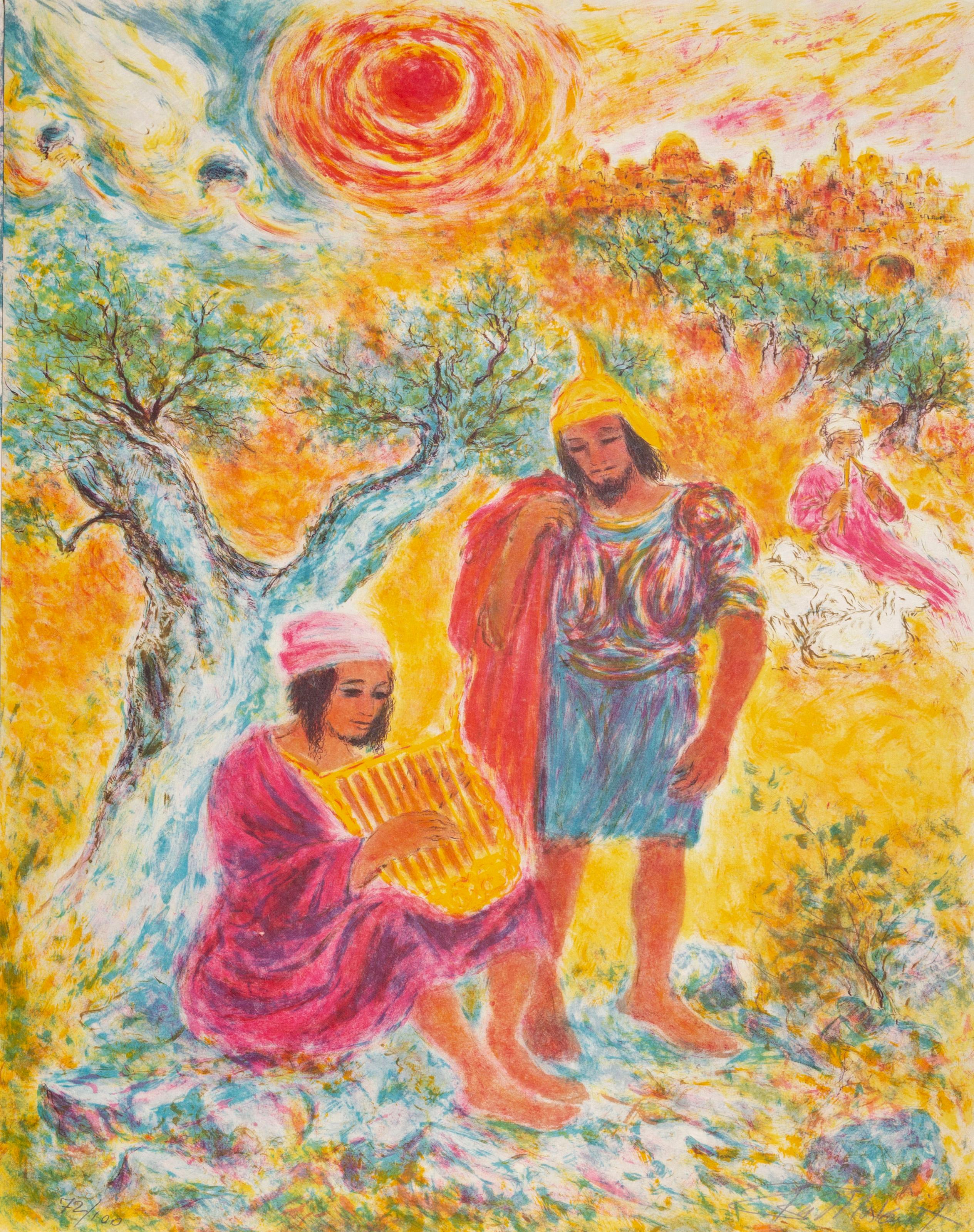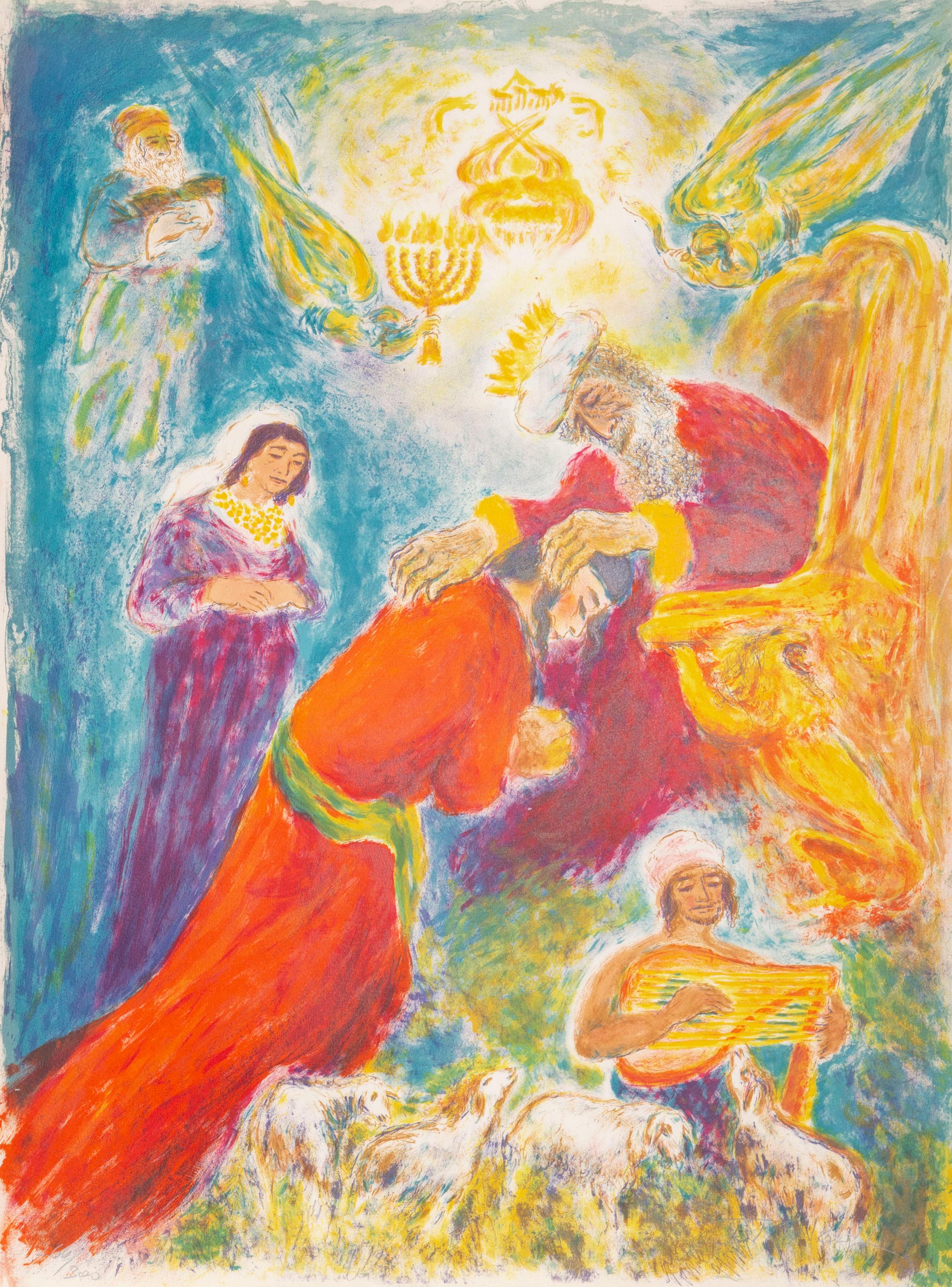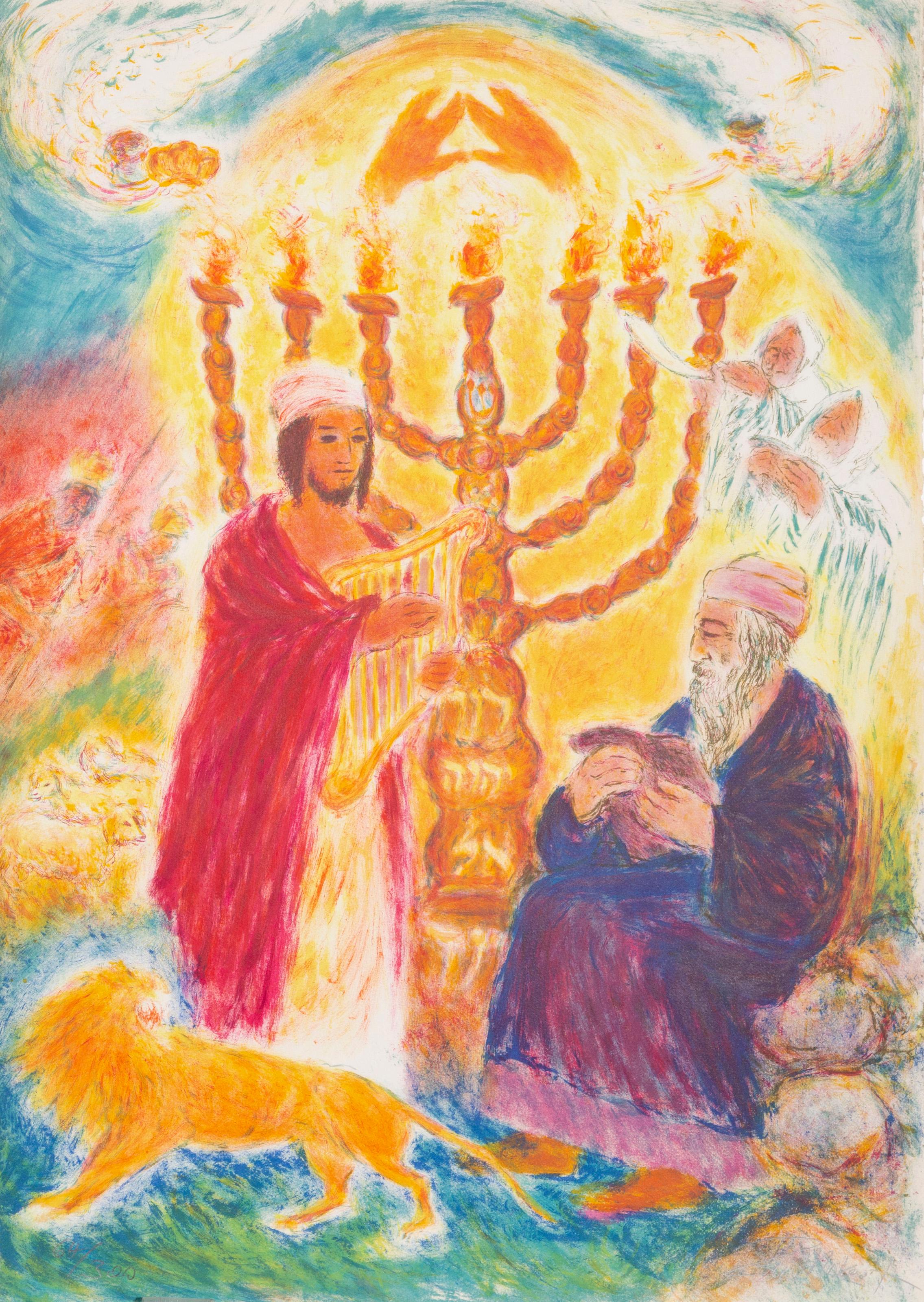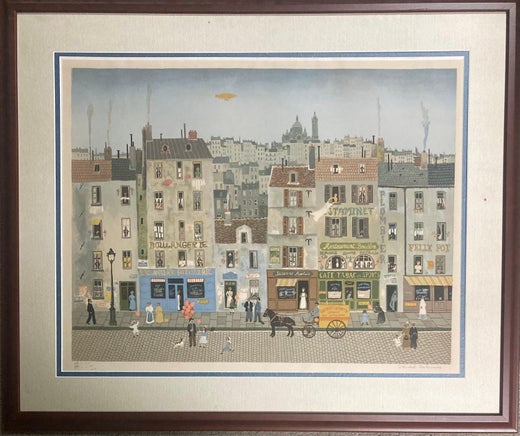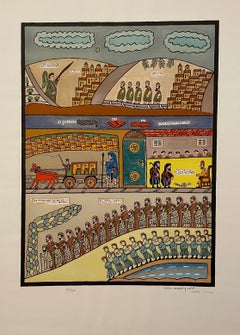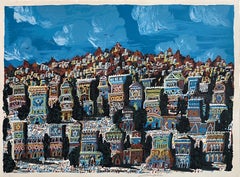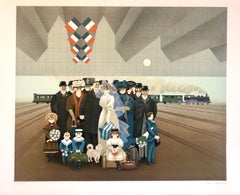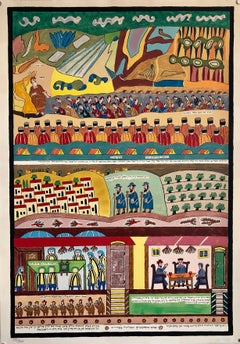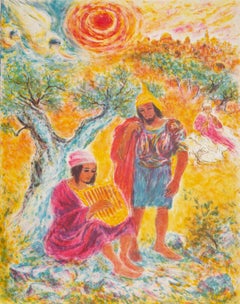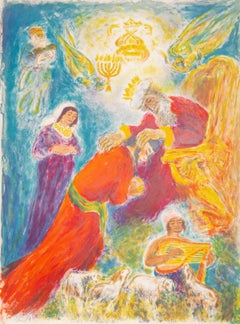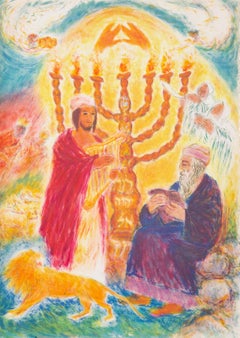Items Similar to Hand signed Folk Art Naive lithograph on Japon Paper Paris French Country Scene
Want more images or videos?
Request additional images or videos from the seller
1 of 15
Michel DelacroixHand signed Folk Art Naive lithograph on Japon Paper Paris French Country Scene
About the Item
Château de Cheverny in the Loire Valley of France
Lithograph in colors depicting an enchanted evening at Cheverny with a horse drawn wagon and carriages on a winter day, Signed in bottom right margin "Michel Delacroix," in pencil and numbered "LXXII/CL" at left. (from the smaller, more valuable, edition on japan paper)
classic paris street scene with bicycle, cafes and shops. Michel Delacroix master of the Naïf (Folk Art or Primitive Naive) the most popular and successful artists in the world today. A self-styled "painter of dreams and of the poetic past," Delacroix has devoted five decades to painting a city he calls "the Paris of then," the magical place where he was born, where he spent his boyhood, and where he continues to live to this day.
But the Paris Delacroix paints is not the urban metropolis of the present. It is the dream-like place the city became in the 1940's, during the Occupation, when "we suddenly jumped fifty years into the past. No more cars in the streets, very few lights. Paris suddenly became very quiet, very dark, and, though people were afraid, there was a brotherhood and spirit that was very delightful." For Delacroix, who was then a child of seven and spared by his age from understanding "the cruelties and absurdities" of war, it was "the one great adventure of my life."
And it is to this special Paris - the Paris of by-gone years and innocent splendors - that Delacroix has returned to over and over again in his gentle works. Theses works, renowned for their graceful balance of "the earthy and the urban, the cosmic and the ordinary," have captivated private collectors, museums and ordinary people alike throughout the world, earning the artist both universal acclaim and numerous awards.
In the U.S. alone, Delacroix's work has been featured in over 275 one person shows, from New York City, Boston, and Washington D.C., to Los Angeles, Carmel, Denver, Seattle, and San Francisco. Abroad, his work has been exhibited in France, Switzerland, Germany, Luxembourg, England, Japan, and forms part of the permanent collections of the Musee International d'Art Naïf and the Foundation Max Fourny in Paris, and of private collections around the globe.
Dimensions:
- Creator:Michel Delacroix (1933, French)
- Dimensions:Height: 25 in (63.5 cm)Width: 31 in (78.74 cm)
- Medium:
- Movement & Style:
- Period:
- Condition:minor wear to paper, should mat out fine. tape remnants verso.
- Gallery Location:Surfside, FL
- Reference Number:1stDibs: LU38215639512
Michel Delacroix
Internationally renowned French painter Michel Delacroix is an acclaimed master of the naïf tradition and one of the most popular collected artists in the world today. A self-styled painter of dreams and the poetic past, Delacroix continued to paint and experiment with a variety of techniques and styles before eventually developing his signature style, depicting scenes of Paris as a happy, timeless and magical place. He has been exhibiting one-man shows all over the world, and his works are collected by major museums and private collectors worldwide.
About the Seller
4.9
Platinum Seller
Premium sellers with a 4.7+ rating and 24-hour response times
Established in 1995
1stDibs seller since 2014
1,745 sales on 1stDibs
Typical response time: 2 hours
- ShippingRetrieving quote...Shipping from: Surfside, FL
- Return Policy
Authenticity Guarantee
In the unlikely event there’s an issue with an item’s authenticity, contact us within 1 year for a full refund. DetailsMoney-Back Guarantee
If your item is not as described, is damaged in transit, or does not arrive, contact us within 7 days for a full refund. Details24-Hour Cancellation
You have a 24-hour grace period in which to reconsider your purchase, with no questions asked.Vetted Professional Sellers
Our world-class sellers must adhere to strict standards for service and quality, maintaining the integrity of our listings.Price-Match Guarantee
If you find that a seller listed the same item for a lower price elsewhere, we’ll match it.Trusted Global Delivery
Our best-in-class carrier network provides specialized shipping options worldwide, including custom delivery.More From This Seller
View AllIsraeli Folk Art Hebrew Naive Judaica Bible Exodus Lithograph Shalom of Safed
By Shalom Moskovitz
Located in Surfside, FL
Vintage pencil signed and numbered limited edition lithograph on deckle edged Arches paper.
Shalom of Sefad (Shulem der Zeigermacher in Yiddish Shalom Moskowitz) Shalom of Tzfat liv...
Category
20th Century Folk Art Figurative Prints
Materials
Lithograph
Israeli Naive Art Screen Print Lithograph Jerusalem, Sanhedrin Old City Folk Art
By Gabriel Cohen
Located in Surfside, FL
Bold color lithograph, hand signed in pencil and numbered AP IX/X (artist’s proof 9/10), Jerusalem Print Workshop blind stamp lower right. On French Arches paper.
Gabriel Cohen, Sel...
Category
20th Century Folk Art Landscape Prints
Materials
Lithograph, Screen
Naive Lithograph Paris Train Station Wedding Party, Honeymoon Scene Folk Art
Located in Surfside, FL
Hand signed, limited edition on BFK Rives French art paper. I believe the title is Honeymoon.
Jan Balet (20 July 1913 in Bremen – 31 January 2009 in Estavayer le Lac, Switzerland), w...
Category
20th Century Folk Art Figurative Prints
Materials
Lithograph
Israeli Folk Art Hebrew Naive Judaica Lithograph Jewish Holiday Shavuot
By Shalom Moskovitz
Located in Surfside, FL
Vintage pencil signed and numbered limited edition lithograph on deckle edged Arches paper.
Shalom of Sefad (Shulem der Zeigermacher in Yiddish Shalom Moskowitz) Shalom of Tzfat lived for over seventeen years in his native town of Safed in the hills of the Galilee. There he worked as a watchmaker, stonemason and silversmith, during the 50's. Since then this self-taught artist has achieved an international reputation. Shalom is a naive painter, but not a rustic one, he expresses a very elaborate way of thinking in his own way. While belonging to Hasidism, Shalom of Safed uses his artistic talents positively. 'I don't paint', he explains, 'to tell the story of the Bible in color and lines. His works have been exhibited in prominent museums and galleries in Europe and the United States, and are included in the collections of the Museums of Modern Art in Paris and New York, the Israel Museum in Jerusalem, the Stedelijk Museum in Amsterdam, the Modern Museum in Stockholm and the Jewish Museum in New York
He has exhibited alongside all of the Israeli great artists. Israel has had a Vibrant Folk Art, Naive art scene for a long time now artists like Yisrael Paldi, Nahum Guttman, Reuven Rubin and even Yefim Ladizhinsky had naive periods. The most well know if the strict naive artists are Shalom of Safed, Irene Awret...
Category
20th Century Folk Art Figurative Prints
Materials
Lithograph
Hand signed Folk Art Naive lithograph on Arches paper Paris Evening Cafe Scene
By Michel Delacroix
Located in Surfside, FL
size includes frame: 32.5" H x 26.5" W;
Lithograph in colors depicting an enchanted evening in Paris with a bright cafe and a church or public building on a charming Paris square. ...
Category
20th Century Folk Art Figurative Prints
Materials
Lithograph
Hand signed Folk Art Naive lithograph on Arches Paper Paris Snowman Scene
By Michel Delacroix
Located in Surfside, FL
Lithograph in colors depicting an enchanted evening in Paris with a snowman and children playing outside the restaurant Chez Joseph on a winter day. Signed in bottom right margin "M...
Category
20th Century Folk Art Figurative Prints
Materials
Lithograph
You May Also Like
Harp Player Beneath The Tree, Folk Art Lithograph by Ira Moskowitz
By Ira Moskowitz
Located in Long Island City, NY
Ira Moskowitz, Polish/American (1912 - 2001) - Harp Player Beneath The Tree, Portfolio: Song of Songs, Year: 1972, Medium: Lithograph, signed and numbered in pencil, Edition: 100, ...
Category
1970s Folk Art Figurative Prints
Materials
Lithograph
King Solomon, Folk Art Lithograph by Ira Moskowitz
By Ira Moskowitz
Located in Long Island City, NY
Ira Moskowitz, Polish/American (1912 - 2001) - King Solomon, Portfolio: Song of Songs, Year: 1972, Medium: Lithograph, signed and numbered in pencil, Edition: 300, Size: 30 x 21 in...
Category
1970s Folk Art Figurative Prints
Materials
Lithograph
Menorah, Folk Art Lithograph by Ira Moskowitz
By Ira Moskowitz
Located in Long Island City, NY
Ira Moskowitz, Polish/American (1912 - 2001) - Menorah, Portfolio: Song of Songs, Year: 1972, Medium: Lithograph, signed and numbered in pencil, Edition: 100, Size: 30 x 21 in. (76...
Category
1970s Folk Art Figurative Prints
Materials
Lithograph
Steam Bath, Aniak
Located in San Francisco, CA
This artwork titled "Steam Bath, Aniak" 1995 is a color offset lithograph on paper by noted American artist Rie Mounier Munoz, 1921-2015. It is hand signed and numbered 38/950 in pencil by the artist. The image size is 6.75 x 10 inches, sheet size is 10.5 x 14 inches. It is in excellent condition..
About the artist:
Alaska painter Rie Mounier Munoz was the child of Dutch parents who immigrated to California, where she was born and raised. She is known for her colorful scenes of everyday life in Alaska.
Rie (from Marie) Munoz (moo nyos), studied art at Washington and Lee University in Virginia. In 1950, she traveled up the Inside Passage by steamship, fell in love with Juneau, and gave herself until the boat left the next day to find a job and a place to live. Since then Juneau has been home to Munoz. She began painting small vignettes of Alaska soon after arriving in Juneau, and also studied art at the University of Alaska-Juneau.
Munoz painted in oils in what she describes as a "painstakingly realistic" style, which she found stiff and "somewhat boring." Her breakthrough came a few years later when an artist friend introduced her to a versatile, water-soluble paint called casein. The immediacy of this inexpensive medium prompted an entirely new style. Rie's paintings became colorful and carefree, mirroring her own optimistic attitude toward life. With her newfound technique she set about recording everyday scenes of Alaskans at work and at play.
Of the many jobs she has held journalist, teacher, museum curator, artist, mother, Munoz recalls one of her most memorable was as a teacher on King Island in 1951, where she taught 25 Eskimo children. The island was a 13-hour umiak (a walrus skin boat) voyage from Nome, an experience she remembers vividly. After teaching in the Inupiat Eskimo village on the island with her husband during one school year, she felt a special affinity for Alaska's Native peoples and deliberately set about recording their traditional lifestyles that she knew to be changing very fast.
For the next twenty years, Rie practiced her art as a "Sunday painter," in and around prospecting with her husband, raising a son, and working as a freelance commercial artist, illustrator, cartoonist, and curator of exhibits for the Alaska State Museum. During her years in Alaska, Munoz has lived in a variety of small Alaskan communities, including prospecting and mining camps.
Her paintings reflect an interest in the day-to-day activities of village life such as fishing, berry picking, children at play, as well as her love of folklore and legends. Munoz says that what has appealed to her most were "images you might not think an artist would want to paint," such as people butchering crab, skinning a seal, or doing their laundry in a hand-cranked washing machine.
In 1972, with her hand-cut stencil and serigraph prints selling well in four locations in Alaska, she felt confident enough to leave her job at the Alaska State Museum and devote herself full time to her art. Freed from the constraints of an office job, she began to produce close to a hundred paintings a year, in addition to stone lithograph and serigraph prints.
From her earliest days as an artist, Rie had firm beliefs about selling her work. First, she insisted the edition size should be kept modest. When she decided in 1973 to reproduce Eskimo Story Teller as an offset lithography print and found the minimum print run to be 500, she destroyed 200 of the prints. She did the same with King Island, her second reproduction. Reluctantly, to meet market demand, she increased the edition size of the reproductions to 500 and then 750. The editions stayed at that level for almost ten years before climbing to 950 and 1250.
Her work has been exhibited many solo watercolor exhibits in Alaska, Oregon and Washington State, including the Charles and Emma Frye Art Museum, Alaska State Museum in Juneau, Anchorage Historical and Fine Arts Museum, Tongass Historical Museum in Ketchikan, and Yukon Regional Library in Whitehorse; Yukon Territory, and included in exhibits at the Smithsonian Institute and Russell Senate Office Building in Washington, D.C.
Munozs paintings have graced the covers of countless publications, from cookbooks to mail order catalogs, and been published in magazines, newspapers, posters, calendars, and two previous collections of her work: Rie Munoz...
Category
Late 20th Century Folk Art Nude Prints
Materials
Lithograph
Feeding the Ravens
Located in San Francisco, CA
This artwork titled "Feeding the Ravens" 1997 is a color offset lithograph on paper by noted American artist Rie Mounier Munoz, 1921-2015. It is hand signed and numbered 29/950 in pencil by the artist. The image size is 9.65 x 8.35 inches, sheet size is 13.85 x 12.25 inches. It is in excellent condition, has never been framed.
About the artist:
Alaska painter Rie Mounier Munoz was the child of Dutch parents who immigrated to California, where she was born and raised. She is known for her colorful scenes of everyday life in Alaska.
Rie (from Marie) Munoz (moo nyos), studied art at Washington and Lee University in Virginia. In 1950, she traveled up the Inside Passage by steamship, fell in love with Juneau, and gave herself until the boat left the next day to find a job and a place to live. Since then Juneau has been home to Munoz. She began painting small vignettes of Alaska soon after arriving in Juneau, and also studied art at the University of Alaska-Juneau.
Munoz painted in oils in what she describes as a "painstakingly realistic" style, which she found stiff and "somewhat boring." Her breakthrough came a few years later when an artist friend introduced her to a versatile, water-soluble paint called casein. The immediacy of this inexpensive medium prompted an entirely new style. Rie's paintings became colorful and carefree, mirroring her own optimistic attitude toward life. With her newfound technique she set about recording everyday scenes of Alaskans at work and at play.
Of the many jobs she has held journalist, teacher, museum curator, artist, mother, Munoz recalls one of her most memorable was as a teacher on King Island in 1951, where she taught 25 Eskimo children. The island was a 13-hour umiak (a walrus skin boat) voyage from Nome, an experience she remembers vividly. After teaching in the Inupiat Eskimo village on the island with her husband during one school year, she felt a special affinity for Alaska's Native peoples and deliberately set about recording their traditional lifestyles that she knew to be changing very fast.
For the next twenty years, Rie practiced her art as a "Sunday painter," in and around prospecting with her husband, raising a son, and working as a freelance commercial artist, illustrator, cartoonist, and curator of exhibits for the Alaska State Museum. During her years in Alaska, Munoz has lived in a variety of small Alaskan communities, including prospecting and mining camps.
Her paintings reflect an interest in the day-to-day activities of village life such as fishing, berry picking, children at play, as well as her love of folklore and legends. Munoz says that what has appealed to her most were "images you might not think an artist would want to paint," such as people butchering crab, skinning a seal, or doing their laundry in a hand-cranked washing machine.
In 1972, with her hand-cut stencil and serigraph prints selling well in four locations in Alaska, she felt confident enough to leave her job at the Alaska State Museum and devote herself full time to her art. Freed from the constraints of an office job, she began to produce close to a hundred paintings a year, in addition to stone lithograph and serigraph prints.
From her earliest days as an artist, Rie had firm beliefs about selling her work. First, she insisted the edition size should be kept modest. When she decided in 1973 to reproduce Eskimo Story Teller as an offset lithography print and found the minimum print run to be 500, she destroyed 200 of the prints. She did the same with King Island, her second reproduction. Reluctantly, to meet market demand, she increased the edition size of the reproductions to 500 and then 750. The editions stayed at that level for almost ten years before climbing to 950 and 1250.
Her work has been exhibited many solo watercolor exhibits in Alaska, Oregon and Washington State, including the Charles and Emma Frye Art Museum, Alaska State Museum in Juneau, Anchorage Historical and Fine Arts Museum, Tongass Historical Museum in Ketchikan, and Yukon Regional Library in Whitehorse; Yukon Territory, and included in exhibits at the Smithsonian Institute and Russell Senate Office Building in Washington, D.C.
Munozs paintings have graced the covers of countless publications, from cookbooks to mail order catalogs, and been published in magazines, newspapers, posters, calendars, and two previous collections of her work: Rie Munoz...
Category
Late 20th Century Folk Art Animal Prints
Materials
Lithograph
Singing in the Bath, Tenakee Springs
Located in San Francisco, CA
This artwork titled "Singing in the Bath, Tenakee Springs" 1996 is a color offset lithograph on paper by noted American artist Rie Mounier Munoz, 1921-2015. It is hand signed and numbered 1077/1100 in pencil by the artist. The image size is 13.5 x 10 inches, sheet size is 16 x 12.35 inches. It is in excellent condition, has never been framed.
About the artist:
Alaska painter Rie Mounier Munoz was the child of Dutch parents who immigrated to California, where she was born and raised. She is known for her colorful scenes of everyday life in Alaska.
Rie (from Marie) Munoz (moo nyos), studied art at Washington and Lee University in Virginia. In 1950, she traveled up the Inside Passage by steamship, fell in love with Juneau, and gave herself until the boat left the next day to find a job and a place to live. Since then Juneau has been home to Munoz. She began painting small vignettes of Alaska soon after arriving in Juneau, and also studied art at the University of Alaska-Juneau.
Munoz painted in oils in what she describes as a "painstakingly realistic" style, which she found stiff and "somewhat boring." Her breakthrough came a few years later when an artist friend introduced her to a versatile, water-soluble paint called casein. The immediacy of this inexpensive medium prompted an entirely new style. Rie's paintings became colorful and carefree, mirroring her own optimistic attitude toward life. With her newfound technique she set about recording everyday scenes of Alaskans at work and at play.
Of the many jobs she has held journalist, teacher, museum curator, artist, mother, Munoz recalls one of her most memorable was as a teacher on King Island in 1951, where she taught 25 Eskimo children. The island was a 13-hour umiak (a walrus skin boat) voyage from Nome, an experience she remembers vividly. After teaching in the Inupiat Eskimo village on the island with her husband during one school year, she felt a special affinity for Alaska's Native peoples and deliberately set about recording their traditional lifestyles that she knew to be changing very fast.
For the next twenty years, Rie practiced her art as a "Sunday painter," in and around prospecting with her husband, raising a son, and working as a freelance commercial artist, illustrator, cartoonist, and curator of exhibits for the Alaska State Museum. During her years in Alaska, Munoz has lived in a variety of small Alaskan communities, including prospecting and mining camps.
Her paintings reflect an interest in the day-to-day activities of village life such as fishing, berry picking, children at play, as well as her love of folklore and legends. Munoz says that what has appealed to her most were "images you might not think an artist would want to paint," such as people butchering crab, skinning a seal, or doing their laundry in a hand-cranked washing machine.
In 1972, with her hand-cut stencil and serigraph prints selling well in four locations in Alaska, she felt confident enough to leave her job at the Alaska State Museum and devote herself full time to her art. Freed from the constraints of an office job, she began to produce close to a hundred paintings a year, in addition to stone lithograph and serigraph prints.
From her earliest days as an artist, Rie had firm beliefs about selling her work. First, she insisted the edition size should be kept modest. When she decided in 1973 to reproduce Eskimo Story Teller as an offset lithography print and found the minimum print run to be 500, she destroyed 200 of the prints. She did the same with King Island, her second reproduction. Reluctantly, to meet market demand, she increased the edition size of the reproductions to 500 and then 750. The editions stayed at that level for almost ten years before climbing to 950 and 1250.
Her work has been exhibited many solo watercolor exhibits in Alaska, Oregon and Washington State, including the Charles and Emma Frye Art Museum, Alaska State Museum in Juneau, Anchorage Historical and Fine Arts Museum, Tongass Historical Museum in Ketchikan, and Yukon Regional Library in Whitehorse; Yukon Territory, and included in exhibits at the Smithsonian Institute and Russell Senate Office Building in Washington, D.C.
Munozs paintings have graced the covers of countless publications, from cookbooks to mail order catalogs, and been published in magazines, newspapers, posters, calendars, and two previous collections of her work: Rie Munoz...
Category
Late 20th Century Folk Art Nude Prints
Materials
Lithograph
